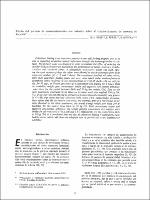| dc.description.abstract | Colostmm feeding is an important practice in any calf feeding program due to its role in imparting protection against infections through the immunoglobulths it contains. The present study was designed in order to evaluate the effect of reducing the number of days of coladmm suckling on the performance of Jersey, Guernsey, Criollo, Ayrshire and crossbred calves. A completely randomized design was used, varying the total number of days the calves were allowed to suckle colosnwn from their respective mothers (0, 1, 3, and 5 days). The experiment involved 48 calves which, after their colostnnn feeding phase was over, were raised under send-confinement conditions which consisted of the administration of 4 kg of whole milk per calf per day for 45 days, ad libitum provision of a concentrate and grazing for 8 hours. Data on mortality, weight gain, concentrate intake and apparent concentrate efficiency were taken for the period Unwed .birth and 50 kg live weight (LW). Data on the same parameters continued to be taken on 24 calves until they reached 100 kg LW. The group that was not allowed to consume colostnnn showed a mortality rate greater (P < 0.01) than those that had colostrum (50% versus 2.8%, respectively). However, those calves that did not receive colostrum, but survived, grew at a rate similar to the rates observed in the other treatments, the overall average weight gain being 369 g/ head/day for the period from birth to 50 kg LW. Both concentrate intake and apparent concentrate efficiency (kg weight gain/kg concentrate dry matter) were similar for all treatments (256 g LW and 1.57, respectively, for the period from birth to 50 kg LW). It is concluded that one day of colostrum feeding is sufficient to raise healthy calves which will show an adequate rate of growth and a low incidence of mortality. | es_ES |


